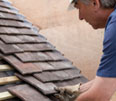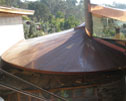Currently, the appeal of a wood shake or wood shingle roof system principally is associated with its appearance. Other steep-slope roof coverings can imitate wood's textures, colors and shapes but rarely are mistaken for the genuine article.
Material property changes resulting from wood's interaction with the environment—referred to as "weathering"—are largely responsible for its aesthetic character. However, these same weathering effects provide indications of a wood roof system's physical condition. Early detection and appropriate response to certain conditions resulting from weathering can make a difference between a wood roof system's need for repair or complete replacement.
Weathering of wood
Wood degradation results from the cumulative effects of ultraviolet (UV) light, stresses from changing moisture content, leaching of natural wood preservatives and decay caused by fungi. The deterioration rate depends on roof slope, roof orientation, shading, climate, air circulation available for drying and wood quality.
Exposed wood roof surfaces become discolored relatively quickly by UV light, which damages wood cells. For cedar, the change from the original orange-brown color to silvery gray can take up to one year but can be more rapid depending on wood quality and severity of sun exposure. Wind and water eventually will erode damaged surface materials. Erosion also causes small surface cracks to develop. These expose additional surface area to UV light and allow water to penetrate deeper into the material.
Wood swells and contracts as its moisture content changes. Spaces left between shakes and shingles accommodate swelling, but the cyclical wetting and drying in typical service eventually fatigues wood. This is visibly manifested as curling, cupping and splitting. Water-repellent compounds naturally occurring in cedar heartwood are responsible for its improved resistance to degradation by moisture-induced stresses.
The term "heartwood" refers to a region of dead wood cells that accumulate in the center of a tree trunk's cross-section. The bulk of older logs is made up of heartwood; younger logs have a lower percentage of heartwood. Heartwood from younger trees, referred to as second-growth, is regarded as less durable. This is a concern because old-growth material is difficult to obtain and more shakes and shingles are being manufactured from younger cedar logs.
Surface fungal growth is the next stage in wood weathering. High humidity, elevated moisture content and persistent shade promote fungal growth on wood. Cedar roofs tend to turn dark gray or black when fungi colonize their surfaces.
When this happens, it is an indication natural preservatives present in cedar heartwood have been depleted in the outer wood layers. These compounds are somewhat water-soluble and leach out of wood over time.
If rain and wind erosion continue unchecked, fungal attack can spread deeper into wood. This is accelerated by a hot, humid climate and other conditions that inhibit drying.
End grain wood in shingles' and shakes' butt areas behaves similarly to a bundle of straws pulling water inside the material. Butt areas take longer to dry, and as a result, natural cedar preservatives typically are most rapidly lost from butt areas and they are more rapidly attacked by wood-rotting organisms.
Eventually, lichens, moss and other vegetation may establish growth on a neglected wood roof system. This is weathering's final phase. Accumulating plant matter retains water and provides favorable conditions for continued fungal attack. At this point, wood loses its mechanical strength and will split and crumble. A roof in this situation eventually will reach a stage where it no longer protects against water penetration.
Wood durability
Western red cedar historically has been and remains the top material choice for wood shakes and shingles. Its natural decay resistance, water repellency, low weight, dimensional stability and straight grain make it well-suited for use as a roof covering material.
Information about wood durability in roofing applications has been published by the Forest Products Laboratory (FPL) of the Department of Agriculture's Forest Service. FPL considers old-growth western red cedar's heartwood extremely durable because of its high content of naturally occurring wood preservatives and water repellents.
FPL indicates grading rules for cedar shakes and shingles have been relaxed during the past few decades. Cedar shake and shingle grading rules are published by the Cedar Shake and Shingle Bureau (CSSB) and are referenced in U.S. building codes.
Comments from established wood roof system installers confirm relaxation of CSSB's grading rules has had a tangible effect on material durability. Installers indicate wood grain and material cut quality have been affected and more sapwood is included in material rated as top-grade (premium-grade cedar shakes and No. 1 Blue-grade cedar shingles) whereas only heartwood was found in these products a few decades ago.
Sapwood, a small amount of which is permitted by CSSB grading rules, is not durable. Sapwood is found outside heartwood in a tree trunk's cross-section. It is composed of live wood cells and serves as conduit for water and nutrients.
Use of cedar shakes and shingles factory treated with a wood preservative is increasing. These products have their natural durability significantly enhanced with a pressure-impregnated preservative known as chromated copper arsenate (CCA). According to FPL, CCA is bound as insoluble residue inside pressure-impregnated wood where it protects against biological growth, decay, insect attack and UV degradation.
According to Pat Skwarok, general manager for Western Wood Preservers Ltd., Aldergrove, British Columbia, the purpose of pressure treating cedar shakes and shingles with CCA is to extend a wood roof system's service life to 50 years with minimum maintenance. He notes CCA pressure-impregnated wood also does not develop black stains from mold.
Western Wood Preservers pressure treats cedar shakes and shingles for CSSB-member saw mills. CSSB recommends using pressure-impregnated shakes and shingles in high-humidity climates such as southeast Texas, the Southeast, the mid-Atlantic and Hawaii.
The American Wood Protection Association's (AWPA's) standard U1-09, "Use Category System: User Specification for Treated Wood," provides requirements for preservative penetration depth and preservative retention rates for preservative-treated wood products. U1-09 specifies CCA preservative for western red cedar and southern pine, which it recognizes as allowable wood species for treated wood shakes and shingles.
Untreated southern pine possesses much less natural decay resistance than western red cedar and is not recommended for use as a roof covering material. Treated pine shakes and shingles currently available from suppliers in the Southeast are pressure-impregnated with alkaline copper quaternary (ACQ), a wood preservative that is used as a replacement for CCA in applications where wood may contact ground water.
Shakes and shingles pressure impregnated with a fire retardant, commonly referred to as fire-retardant-treated (FRT) shakes and shingles, are a separate product category. Treatments are composed of basic salt solutions, binders and UV inhibitors. FRT wood roofing materials are not designed to resist biological attack. AWPA U1-09 provides performance requirements for FRT products.
Housekeeping basics
NRCA recommends all building owners and homeowners schedule roof system inspections at least twice per year in the spring and fall. Roof system inspections also are recommended after severe weather events such as storms accompanied by strong winds or hail.
A roof system inspection's objective is to assess a roof system for problems before damage occurs. An inspection also provides the opportunity to remove plant debris from a roof. A professional roofing contractor should identify potential trouble areas and take appropriate preventive maintenance steps, but an owner can perform basic housekeeping tasks that can make a difference in a roof system's service life.
Generally, owners should not climb onto roofs. Instead, they should make observations from the ground or, if necessary, from a ladder extended at least 3 feet above a roof line and tied to the roof's edge. Rooftop walks necessary for close-up inspection, debris removal and repairs are best left to professional roofing contractors.
On wood roof systems, plant matter usually accumulates in roof valleys, gutters and chimneys and settles in the spaces between shakes and shingles. Garden hose water pressure is recommended if sweeping with a stiff broom is insufficient to remove debris from a roof surface.
Shaded areas of wood roof systems dry slowly and are among the first to be colonized by fungi, which is later followed by lichens and moss. If surrounding trees cast shade over a wood roof system, trimming tree branches to a perimeter several feet outside the roof line is recommended. A professional should remove lichens and moss and assess the affected areas for decay.
Other potential trouble spots for wood roof systems include split, curled, cupped, loose or missing shakes and shingles in a roof's field and hip and ridge pieces that are loose, missing or open at joints. A professional roofing contractor typically can restore a wood roof system to good condition provided the wood hasn't decayed.
Maintenance and repair
It should be understood a wood roof system requires planned maintenance if it is to provide a service life commensurate with its purchase cost. The combination and severity of local factors influencing wood weathering and durability determine maintenance type and frequency. Building owners and homeowners should consult established wood roof system installers and maintenance service providers for recommendations.
An experienced professional roofing contractor should perform maintenance work other than basic housekeeping. Wood roof system maintenance tasks that should be left to professionals include protecting the surrounding area from damage by debris or chemical overspray; applying chemicals for moss and fungi control; removing plant growth and stains; power washing; applying water-repellant, UV-blocking, preservative and restorative treatments; and repairing or replacing damaged shakes and shingles.
Field-applied treatments
Topical treatments prepared and/or marketed for application to wood roof systems use ingredients from the following categories:
- Detergents and bleaching agents
- Fungicides, herbicides and pesticides
- Pigments/UV absorbers
- Wood preservatives
- Water repellants
- Restorative oils
It is common for field-applied treatments' marketing materials to indicate some combination of benefits.
Regarding topical treatments for cedar roof systems, CSSB's general recommendations are to use products that are labeled as cedar treatments; have material safety data sheets; feature water repellents, UV inhibitors and/or wood preservatives registered with the Environmental Protection Agency; and have manufacturers' performance guarantees. CSSB recommends avoiding products that make outrageous claims; claim to be fire retardants; are sealing, waterproofing or plasticizing agents; and/or contain unfortified linseed oil, diesel fuel or motor oil.
Methods and procedures
Attention to detail should show through in a wood roof system maintenance provider's work. First, steps should be taken to keep debris and overspray off vegetation and vulnerable areas. Protective plastic tarps or sheets commonly are secured with rope or adhesive tape. Later, while one technician applies a treatment to a roof, a second technician should be on the ground ready to rinse overspray and runoff with hose-pressure water.
Plant growth and debris are removed either by sweeping, brushing and scraping, or washing. Spraying or brushing on a detergent or bleach solution and scrubbing with a soft brush can help remove stubborn stains.
In some instances, applying herbicides may be a more effective method if sweeping or scraping fails to dislodge plant matter from recessed spaces. This can introduce a delay in subsequent work as it may take several days before dead plant matter can be dislodged. It is important to note topical herbicides do not provide durable protection against future plant growth.
Wearing protective clothing and safety devices and following specific cleanup instructions are considerations for technicians working with herbicides. And because some herbicides corrode metal, applicators should take appropriate steps to protect flashings and gutters.
Placing exposed zinc or copper on a roof has been found to provide long-term control of moss and algae growth. This type of treatment relies on growth-inhibiting metal ions being uniformly distributed over a roof's surface by runoff. This approach is better-suited to wood shingles because of their more regular texture as compared with wood shakes.
For instance, 3-inch-wide copper strips may be fastened to shingles with screws near a ridge so a 2-inch-wide section is exposed along the ridge's length. Additional strips are installed downslope at 10-foot vertical spacing or less as determined by a roofing professional's preference.
Some contractors recommend pressure washing, but others prefer dry methods or washing with hose-pressure water. High-pressure water will remove debris and dead surface cells and restore wood's unweathered appearance. Following a drying-off period, a protective topical treatment should be applied to a pressure-washed wood roof system as the final step in a maintenance regimen.
There is concern that pressure washing can force large amounts of water into a wood roof system and damage or dislodge shakes and shingles if not done carefully. A professional should determine whether it is appropriate to use pressure washing.
Depending on the cleaning method, technicians may tend to repairs immediately or allow some drying time. Splits in otherwise sound shakes and shingles can be repaired by inserting prefinished metal shims under split pieces. Some damaged areas may require pulling out or cutting roofing nails to remove and replace shakes and shingles. Hip and ridge covers are common maintenance items because they are vulnerable to separating at joints and sliding out of place. Technicians should ensure all hip and ridge joints are tight.
Once cleaning and repairs are completed, a wood roof system can receive a topical treatment. Spraying is the application method most commonly used. Good application technique aims to uniformly distribute the treatment over exposed shingle and shake faces, as well as the end grain wood at butt edges. A technician stationed on the ground should immediately use hose-pressure water to rinse overspray from surfaces and douse the ground to dilute and flush away any runoff.
Wood species, factory treatment, roof system condition and local weathering factors should be considered when selecting a treatment for field application to a wood roof system. Wood roof system owners should rely on an established wood roof system maintenance service provider for recommendations.
Post-treatment, a roof's surface should display improved water repellency. There may be a change to a darker color from iron oxide pigment included as a UV inhibitor in some treatments.
If the objective of treating a wood roof system is to stain it a different color, penetrating stains are recommended. Film-forming coatings or sealants should not be used because they may trap moisture in a roof system.
Treated wood
CSSB's publication "Cedar Roof Care & Maintenance" provides the following recommendation: "Pressure-impregnated treated Certi-Last® (preservative) or Certi-Guard® (fire-retardant) products should not receive aftermarket roof treatments without written permission from the manufacturer of such products."
Troy Welsh, who handles sales and technical questions for Watkins Sawmills Ltd., Mission, British Columbia, a CSSB member and manufacturer of FRT shakes and shingles, does not recommend using aftermarket wood preservatives or dressings to treat FRT wood roofing. Welsh recommends using bleach solutions to remove existing mold or moss growth and installing zinc or copper strips to prevent future growth.
Skwarok contends CCA pressure-impregnated cedar roofing materials do not require aftermarket treatments. If a topical treatment is desired to enhance water repellency or stain a CCA-treated roof a different color, it will not negatively affect a roof. CCA-treated wood is expected to have improved color stain retention because the metal content acts as a primer.
Maintenance and disposal recommendations for CCA-treated wood from Environment Canada can be found at www.ptw-safetyinfo.ca/cca.htm. Cleaning CCA-treated wood with solutions containing bleaches, oxalic acid or citric acid is not recommended; doing so may release toxic chemicals. Pressure-impregnated preservative treated wood never should be disposed of by burning because toxic chemicals may be released in smoke and will be concentrated in the ashes.
Additional information
More information about maintaining wood roof systems can be found online. FPL's searchable online library at www.fpl.fs.fed.us/search/index.php has a number of documents addressing wood applications in construction and treatments for wood preservation and maintenance. Recommendations also are available from CSSB at www.cedarbureau.org.
Maciek Rupar is an NRCA director of technical services.



